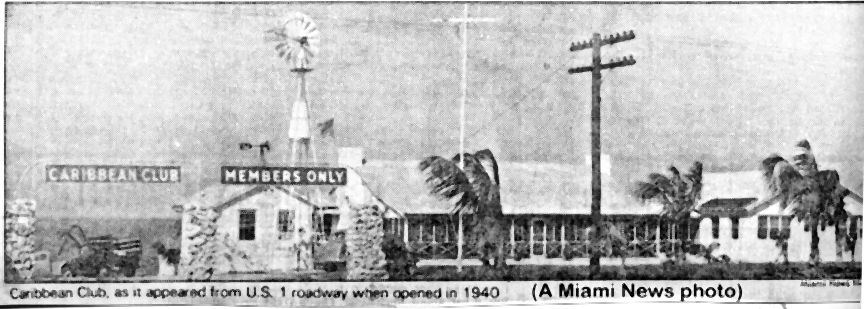|
- HISTORY OF THE UPPER KEYS -
Caribbean Club (Key Largo) - By Jerry Wilkinson - Compilation
date = October 2011
[I have more images than I do text; therefore, the image may not be juxtaposed to the text-JW]
One reason for taking a lot of time writing the history of
one building is it demonstrated the complexities of writing Upper Keys
history. I refer to real history and not just a story. From
looking through many web sites of which many have a tab titled
"history." I think the word is a very misused word. Even when end notes
are used, there subject I want to research has no end note, or it is a
300 page book. I moved to Key West in 1947 on a motorcycle and do
not actually recall ever noticing it. My recollection of how far apart
structures were in the Upper Key, I feel certain that I saw it but with
a speed limit of 65 mph and I was traveling at least 70 mph it my
attention would have been more on the driveways.
At the conclusion of World War-I, the economy of the U.S. was well off
and its citizens had more disposable income. These funds and the
production of the automobile and other transportation devices made the
public more mobile. Of special interest to South Florida was the
completion of the Dixie Highway in 1925. A warm, sunny, beach vacation
within a few hours seemed almost impossible even with the steamships
traveling to and from Europe much faster. Accompanying all this was the
Florida Land Boom from 1922 to 1926 and its advertising and promotions.
Also accompanying all of the above, was the developer of the Indianapolis Speedway and the Prest-O-lite Company - Carl Graham Fisher - who had purchased a winter home in Miami in 1910. Fisher transformed the offshore barrier reef of Biscayne Bay with his funds and permits from the State into Miami Beach which was incorporated in 1915. He then decided to build artificial islands between the mainland and Miami Beach, By 1926, he built five islands and the Venetian Causeway. Most of his properties soared in assessed evaluation 200 or more times. Miami Beach attracted a new group of wealthy folk who did not have to finance if they chose not to. Many of these were Midwesterners, but Miami Beach did capture a few Vanderbuilts and Astors, but there were far many more like Firestone, Hertz, Maytag, Florshein and Honeywell. A few found North Key Largo to build the Key Largo Angler's Club. Henry Flagler had led everyone to the islands south of Miami when he used Soldier's Key in 1904 as a supplemental recreation area to his Royal Palm Hotel on the Miami River. Carl Fisher, and others like the Honeywells on Boca Chita Key, started with ventures on the surrounding waters and built the Cocolobo Cay Club on Adams Key at the west end of Caesar's Creek in 1916. Many wealthy captains of industry, politicians and entertainers became members of the Club. The Great Depression brought the club's demise and it was sold. Fisher continued his development thoughts to Long Island, New York (Montauk) in 1926 and then turned to Key Largo to build the Caribbean Club - his last project. Unlike his other undertakings, the Caribbean Club was for folk of modest means. It could have been because the Great Depression left his almost penniless, but obviously he was not down for the count. He never lived to see it completed as he died July 15, 1939. This Miami Daily News articles is general article with some of the aforementioned info that I have given above. It does give details that I have never found else where. For example the "....person in charge of cuisine is Roy E. Harris...." But more important are those the Fisher "...selected the club's directorate and insisted to them his wishes br carried out. The directors includes P.H. Arthur, Philo M. Gelatt, N. Vernon Hawthorne, John Oliver LaGorce, N. Vernorn Hawthorne, Commodore Hugh Matheson, William Muir, Thomas J. Pancoast, F. Lowery and C.W. Chase...." Most of these were wealthy Miami Beach citizens and some member of the prestigious '100 Club.' I believe the hotel partially seen at the left is connected to club at least by a covered walkway. Note the screened porches of which the rear one is said to have been later closed in for the gambling apparatus. The Fisher deed stipulated that if ever should cease to be operated as a club, the buildings and land should be turned over to a benevolent institution. I wonder how that ever turned out? The front view from the highway is shown in an later Miami News article. The second article stated that it was opened January 28, 1940. The article also addresses the fire that destroyed the hotel on March 18, 1955 and the scandal of a doctor and a young lady which died in the hotel. Below is clear a sign "For Members Only." These two images are from very old faded newspapers. My present knowledge of the Caribbean Club continues when I interviewed fishing guide Captain Roger Martin of Islamorada in 2007. Roger had had polio in 1945 and it affected his right leg. His parents knew Tom Hanley, who owned the Caribbean Club at that time, and also lived next door in a modern 4-bedtoom house. This acquaintance arranged for Roger to spend free time with the Hanley's and perform non-weight- 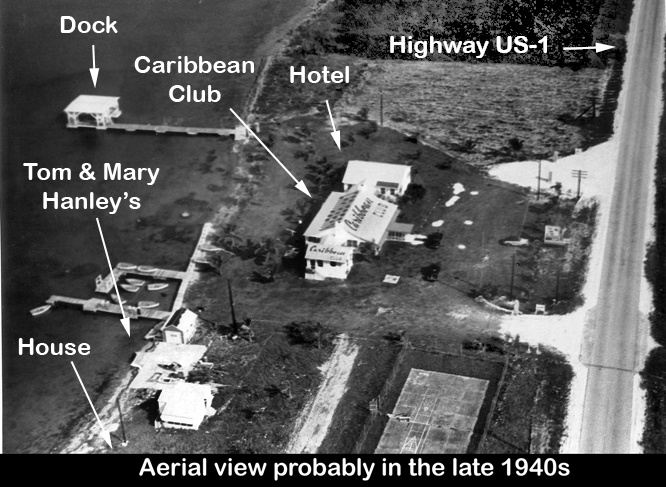 bearing exercise by swimming between the
Hanley
private dock and the one of the Caribbean Club. I am of the opinion
that at that time it was all one piece of property. The general theme
of Carl Fisher is that he would not have purchased a small piece of
property and the chain of ownership would require an attorney search.
The microfilm is, or at least was, at the Plantation Key government
center by my request of the county clerk. bearing exercise by swimming between the
Hanley
private dock and the one of the Caribbean Club. I am of the opinion
that at that time it was all one piece of property. The general theme
of Carl Fisher is that he would not have purchased a small piece of
property and the chain of ownership would require an attorney search.
The microfilm is, or at least was, at the Plantation Key government
center by my request of the county clerk.Roger's memories go back to 1946 and his first trip over the old wooden swing bridge at Card Sound and his first fishing experience at Whale Harbor. I collect postcards and from it have documented photos; however, only one was postmarked - 1952. However, there is one photo which I believe is earlier than the postcards and it is at the right. Click to enlarge. I say earlier as the entrance driveways do not appear as developed as I think they should and I do not see the large highway signs that were erected after the movie Key Largo (1948) was made. There were two of these large signs made some time after the movie was made for traffic approaching from either direction. The tennis court at the lower right seemed to have been used mostly but owners Tom and Mary Hanley's dogs. For the fear of exaggration I will not state an number, but over 10 at one time it was 14. There is little to no written history of what I am stating as 'history' on this web page. There were no newspapers, no city directories, no local government offices, but there was a telephone directory in 1952 - the phone number for the Caribbean 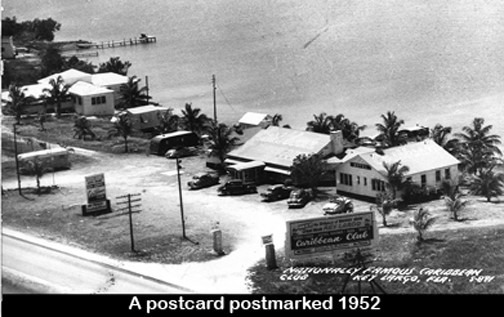 Club was 9711. Key Largo had page on
private and business numbers, Plantation, Windley, Upper and Lower
Matecumbe a little over one page and the Middle Key abut the same. As
the end of World War
I
increased the mobility of the public, World War II did the same to a
much larger population. No doubt the installation of electricity, a
water line and opening the
so-called '18-mile stretch' gave
commercialism a great boast. The highway from the mainland to Key Largo
was a seven mile shorter trip
to/from the mainland and over a
stretch of modern highway plus only two sweeping curves. The old route
to Cardsound was discontinued. Club was 9711. Key Largo had page on
private and business numbers, Plantation, Windley, Upper and Lower
Matecumbe a little over one page and the Middle Key abut the same. As
the end of World War
I
increased the mobility of the public, World War II did the same to a
much larger population. No doubt the installation of electricity, a
water line and opening the
so-called '18-mile stretch' gave
commercialism a great boast. The highway from the mainland to Key Largo
was a seven mile shorter trip
to/from the mainland and over a
stretch of modern highway plus only two sweeping curves. The old route
to Cardsound was discontinued.At the lower right is a photo of the dedication presumably of the signs, but could be a reopening. From the comparing the size of the people, the signs were huge. There was a small highway directly out from the entrance but these two dwarfs it. At the lower left corner it is noted that it is "Not Private." It can be dates as post 1948 as across the top it states "This is the birthplace of the Warner Bros. great movie KEY LARGO." This statement can be substantiated by most writers of biographies of John Huston. The combined stories go like this: John Huston and Richard Brooks and their wives come to the keys (none say absolutely Key Largo) to write the screen script out of season and every thing is closed. They contacted the owner and leased the 'resort' (do not give a name). A cook and waitress was brought in and the owner discovered that Huston liked to gamble and installed various gaming devices. John gambled at night and slept all da 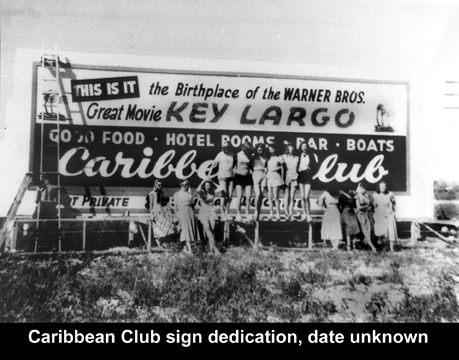 y - work
on he script disappeared. Their wives, Evelyn and Harriet, took a plane
to the Bahamas and came back a week later, Evelyn bring a monkey back
for John. John had lost $10,000 and Richard $8,000, and John took a few
local photographs. The four flew back to Los Angeles with the pet
monkey. y - work
on he script disappeared. Their wives, Evelyn and Harriet, took a plane
to the Bahamas and came back a week later, Evelyn bring a monkey back
for John. John had lost $10,000 and Richard $8,000, and John took a few
local photographs. The four flew back to Los Angeles with the pet
monkey.I have three books of John Huston, which I will donate to the library when I am finished, and they are: 1) An Open Book, John Huston. My copy on the Library of Congress page states it was originally published: New York Kroft, 1980. 2) The Cinema of John Huston, Gerald Pratley, 1977 by A. S., Barnes and Company, Inc., 3) John Huston, a Biography by Axel Madsen, Doubleday & Company, Inc, 1978. Here is what is on page 150 of An Open Book by John Huston copyright 1992 by DA CAPO PRESS: "... I has decided ny next film Key Largo was to be my last for Warner Brothers. Not only was I put out by Jack Warner's refusal to permit me to direct O'Neil's A Moon for the Misbegotten back in 1946, but I was dissatisfied in the studio in general.... It was in this mood and unfortunate set of circumstances that I started work on Key Largo. "Jerry Wald was the producer. He put Richard Brooks with me to help with the screen play, and we went do 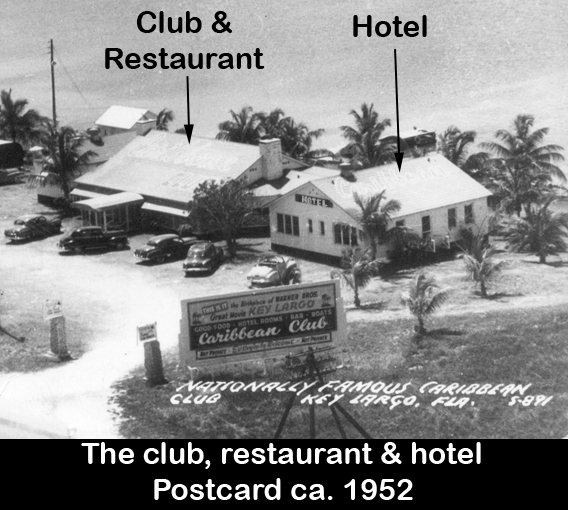 wn to the
Keys - my first visit there - and wrote it on the spot. Evelyn [John's
wife] and Dick's wife, Harriet accompanied us. We arrived out of season
and there wasn't any suitable places to stay, but we finally discovered
a small hotel which looked attractive, and persuaded the owners to open
the place for us before the season started. We had no sooner settled
down to work than they moved in a dice table, a roulette wheel and a
blackjack table. Thereafter, when Richard and I weren't writing, I was
gambling.... wn to the
Keys - my first visit there - and wrote it on the spot. Evelyn [John's
wife] and Dick's wife, Harriet accompanied us. We arrived out of season
and there wasn't any suitable places to stay, but we finally discovered
a small hotel which looked attractive, and persuaded the owners to open
the place for us before the season started. We had no sooner settled
down to work than they moved in a dice table, a roulette wheel and a
blackjack table. Thereafter, when Richard and I weren't writing, I was
gambling...."Since the major part of the action in Key Largo took place in a resort hotel, we were able to do most of the shooting in the Warner Brothers studio. A few mood shots were done in Florida. It was nominated that year for a Best Picture, and Claire Trevor got the Oscar for the Best Supporting Actress...." Author Axel Madsen has a different versions but the same theme. A small quote is from Page 86: "... Huston shot 90% of the picture at the Warner's stages. He did get to go to Florida for some moody location photography and managed to stay away from the gambling." Author Gerald Pratley on about mid page 64 writes: "...Although we wrote it at Key Largo, it was filmed entirely in the studio. There were some outsides scenes, I recall, on a boat; these were done in a tank in the studio....." Please note that none of these sources state where they leased and what hotel to write in. As a matter of fact, there were two other Upper Keys resorts they could have used. Only the author Tratley names Key Largo. Regardless, there was the Key Largo Angler's Club on North Key Larg 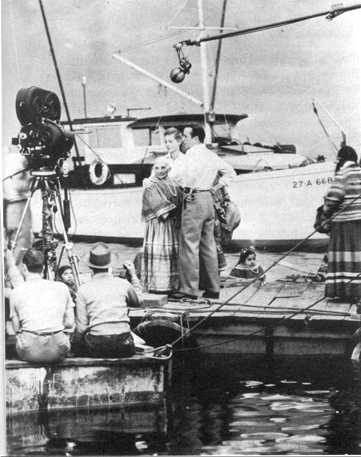 o and the Oldney Inn at Islamorada, now the
Cheeca Lodge
and both had water frontages. o and the Oldney Inn at Islamorada, now the
Cheeca Lodge
and both had water frontages.Also, nothing other than the 'off season' are the actual dates known. Also, not known are the filming dates. The aforementioned three books give sufficient for a scenario to be invented. Editors comment re this. In the 1990s when I got heavily into the research, I contacted Warner Brothers Studio and located several employees who said they had personal knowledge of the filming, none actually witnessed the filming. The boat, dock and hotel scenes were definitely filmed on set. The highway scenes were a combination of models and the Pacific Coast Highway along the Pacific Ocean with the open sea shots made off of San Pedro. San Pedro is a California coastal community south of Hollywood. My primary contact was a Leith Adams, Corporate Archives, Warner Bros. Burbank CA 91522, 818-954-4776 based on a September 2, 1887 letter. In this letter he does not say much other than "...nothing was ever filmed on the Florida Keys...." The primary purpose of his letter was to guide me for documentation which is: All the daily production reports, memos, set drawings and photos are at: Warner Bros. Archives, Cimema-Television Library, USC Doheny Library, Los Angeles, CA 90089-2211 ... Attn. Ms. Noelle Carter.... USC does not answer research questions, but the files are there and can be looked at in a Special Collections Room by anyone giving advance notice. I hope this letter has been some help...." The USC Doheny Library is near downtown LA at 3550 Trousdale Parkway. If someone is in LA and has the time, we need copies of their Key Largo movie data. I made other telephone and correspondence but did not keep any records, or they have been lost because of computer hard drive failures. I stopped my research when Mr. Jimmy Hendricks, owner of the "African Queen" on a chance meeting volunteered to assist me contacting Ms. Lauren Bacall. He possessed vast knowledge gained from his contacting Kathern Hepburn of the movie African Queen. With Jimmy's assistance, I finally located Ms. Bacall, Jimmy obtained her phone number, and I called her several times until finally the phone was answered by her secretary. I introduced myself, told her of my plight, and wanted to ask Ms. Bacall one short question ( I am certain she had heard this many times) which was, "Was she ever on the Island of Key Largo?" I was told she was not available, so I asked her if she would relay the question - which she did! It was a good telephone connection and I heard Ma. Bacall reply clearly by weak: "No.'" Not realizing that I had heard her actual response, the secretary told me she said, "No." But, while this was going on, 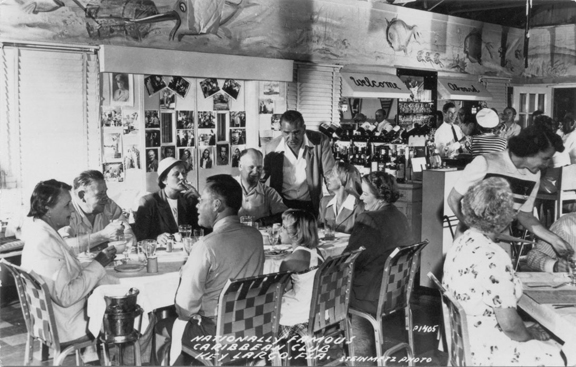 Ms. Bacall
said, and I heard it in the background; "Tell him that I was in Key
West at one time." Not pushing it, I thanked her and gave them my best
wishes and hung up. I was and am still satisfied.! I could have made
this story up but my wife knows it occurred even though she did not
hear the actual conversation - I had called so many times, it surprised
me
also. There is a local story that Ms. Bacall came back to the club
yearly to
visit so that is debunked - there are many local stories. Ms. Bacall
said, and I heard it in the background; "Tell him that I was in Key
West at one time." Not pushing it, I thanked her and gave them my best
wishes and hung up. I was and am still satisfied.! I could have made
this story up but my wife knows it occurred even though she did not
hear the actual conversation - I had called so many times, it surprised
me
also. There is a local story that Ms. Bacall came back to the club
yearly to
visit so that is debunked - there are many local stories.I went to Key West and researched the Key West Citizen's microfilm. In a November 5, 1947 paper I found and to quote again: "...Humphrey Bogart and Laureen [sic] are due to arrive in Key West, Saturday, November 15 (1947) for a stay of five days..." Then a second article on November 15, 1947: "Bogart, Bacall Expected Here Later In Day... The Bogarts intend while here for about five days to enjoy the fishing in Key West waters." The may seem strange as they supposedly divorced in May 1945. No mention of the movie 'Key Largo' was in either article; albeit, they mentioned other earlier movies - I do not think it had been filmed yet. I understand it required only 78 days (have heard other time periods) to film. 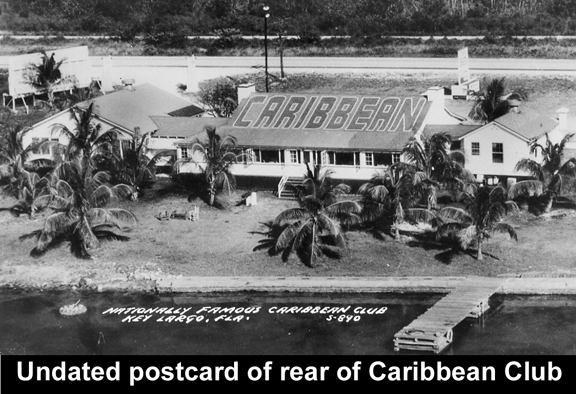 One more newspaper article from The Miami Herald, Section B dated July 18, 1976: "'Key Largo'- More Than a Memory.... That's the way it is at he gulf side Caribbean Club, a simple linoleum floored bar that once hosted the cast and crew of "Key Largo" a 1948 Twentieth Century Fox production about ....." I wonder what happened with the research of this article. It is true that Darryl Zanuck used to work for Warner Brothers but he left to join Fox. Warner Brothers was a 1903 formed film company and 20th Century Fox was 1933. Here is another newspaper about filming the movie here. [I have actually spoken with real folk who actually served the actors food, etc.-JW] In an April 26, 1976 Keynoter, page 12 (published in Marathon) article titled, 'We get LETTERS, sub title, The Key Largo Flick: "... In a scrap book of clippings on Florida Keys events I find an undated clipping from an unknown source which reads as follows: "Third sentence of the above mentioned article reads: Even though the film was not shot at the Caribbean Club and Bogie, Bacall and Robinson would have never been caught dead in Key Largo in the 1930's-- the place ought to be considered a monument to creative fact making. In a scrapbook of clippings on the Florida keys events I find an undated clipping from an unknown source which reads as follows: 'For the millions of viewers who saw 'Key Largo' on movie screens in 1948 and several times on television in 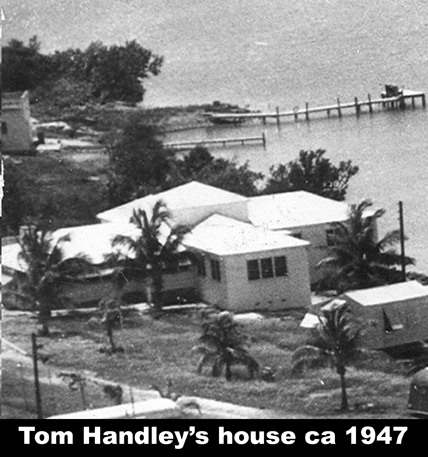 the past
few years, this is to clear up two script lines of the late actor
Lionel Barrymore, to wit: the past
few years, this is to clear up two script lines of the late actor
Lionel Barrymore, to wit:'The mosquitos are so bad here, you can't go outside.' And, the temperature here never gets lower than 100 degrees.' Although the movie put Key Largo on the map, so to speak, and helped Claire Trevor to win herself an Academy Award as a supporting actress, it also helped to stifle tourism there for years. Said Harry L. Harris, then president of the Chamber of Commerce, 'We complained, we beefed, we squawked. The movie company didn't even answer us. The damage was already done. The film had scared tourist away.' [The Chamber of Commerce was formed in December 1947 with Hubert McKenzie as president with Harris one of the directors. Harry Harris was elected County Commissioner of District 5 the following May 4th and I doubt that he was the president-JW] Harris recalled that the late Humphrey Bogart, Lauren Bacall, Edward G. Robinson and camera crews spent about three weeks at the Caribbean Club. 'But when we saw the picture we could recognize only one scene that was actually shot in the Keys. It showed a bus crossing the bridge at Channel Five near Craig Key." [That too was made on set-JW] The rest was made in studios in Hollywood.' The truth is said Harris, 'that we average about 70 degrees here year round and the mosquitoes, are little ones, and not too bothersome when they do come around." [Average annual temperatures is not much of a meaningful number. [I use 77.8 degrees if you are on the ocean side. Having lived on the highway, on Florida Bay and the Atlantic ocean, the t 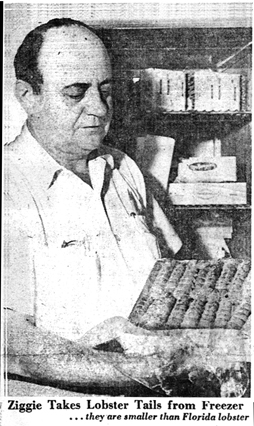 emperature experienced can be significantly
different at
each location. I know were
Harry Harris lived and it was not 70 degrees there, but with climate,
it changes all
the time - JW] emperature experienced can be significantly
different at
each location. I know were
Harry Harris lived and it was not 70 degrees there, but with climate,
it changes all
the time - JW]From here a little about the operation and management of the Caribbean Club in the late 1940 based on a conversation with Roger Martin whose father owned about half the nightclubs in Miami. Photos will be shown at the right with captions. The text I have occupies much less space; therefore, the images will not be exactly aligned with the accompanying text - they could be if I made them extremely small, which I have not. By those times, Tom and Mary Hanley lived in a relatively modern concrete house. Mary was a Miami nurse and had two brothers, Junior and Thurman who worked in Key West. The club was managed by Ziggy Stocki. Ziggiy's actual name is Sigmund and worked for Hanley at the Caribbean Club, moved with Hanley to Marathon as manager as Hanley's Place and the Sombrero Beach club, until he struck out on his own to operated a new restaurant of the Oldney Inn - owned by Clara Mae Downey. Ziggy was married with two children. I do not recall his wife's name, but she and one of her sons operated the Conch Restaurant after Ziggy passed away. Ziggy left Hanley prior to Hurricane Donna (1960) . Why all this about Ziggy? Well it could have been the only Keys character name in the movie. As the storm abates Rocco (Edward G. Robinson) received a visit from his old gangland crony, Ziggy, who had come to buy a shipment of counterfeit money, and Ziggy departs in the rain. Some think that Huston came up with the name Ziggy who the Ziggy had served the writing crew for the screenplay. Np proof of that either, but the coincidence is possible as two Ziggy's is rare. In the movie, Ziggy is played by Marc Lawrence. 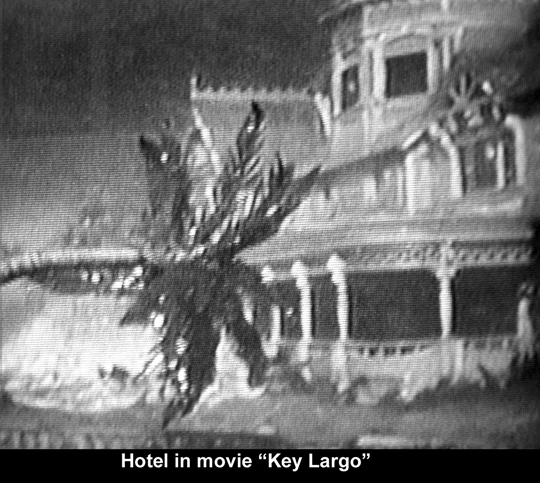
The release of the movie created attention for Key Largo, but Key Largo
was just an island. The only two
post offices were Rock Harbor and Tavernier. For tourists there was a
natural curiousity of where was the hotel. Below right is a frame
from a VHS copy that I somehow copied in 2007 while trying to edit the
interview with Roger Martin. The scene was between lightning flashes
during the hurricane. The palm tree at the left gave it a little Keys
realism, but puruists tell me the the palm fonds would have evoked more
wind force, The only two-story hotels were at Tavernier and the
Olney Inn on Upper Matecumber Key and neither of these compared to one
in the movie with the wildest of imaginations.
Immediately below is the Caribbean dock with Humphrey Bogart and Lauren Bacall walking down the dock heading back to the hotel. Note the ramp down to a loading platform for small boat 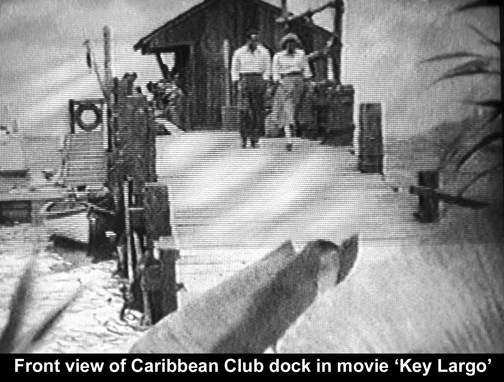 passengers to left. passengers to left.Below right and below the hotel image is hurricane scene captured of the hurricane on the Caribbean Club dock during the hurricane. 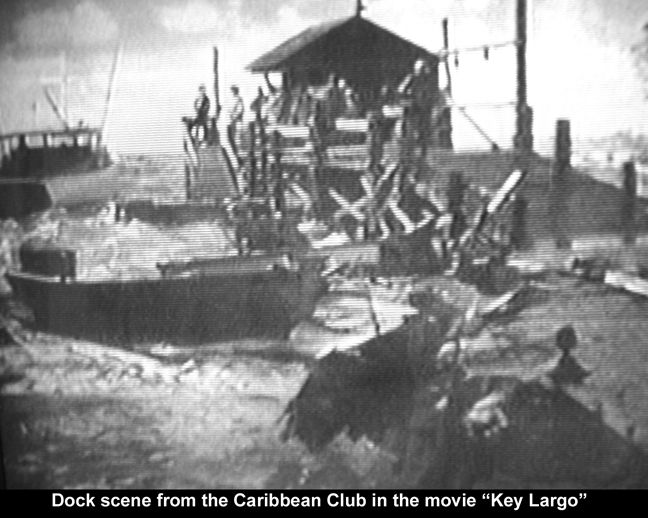 Figure out how to display the pixs and then can bring in the Hanley opening the Mara place and at somet ime bringiing Ziggy to Mara, then most likely selling the CC. Then the 1955 fire. Look for this Krome or whatever suspected mgr name, Transition to Ruthie Whitehouse says she bought from Raymond Craig - who was he? 
. . . . . . . . . . . . . . . . . . . BACK to PAGE ONE |

